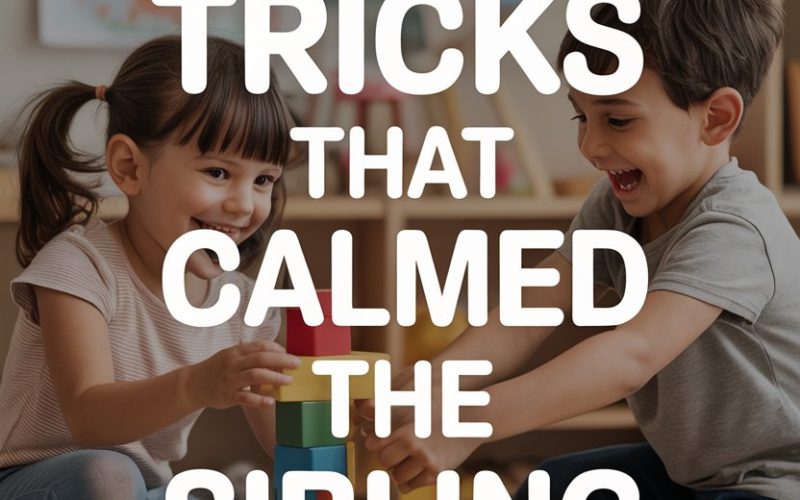Ah, sibling chaos—the symphony of squabbles, tattling, and that unmistakable “she’s looking at me funny” stare. If you’ve ever found yourself wishing for a mute button or a parental pause, you’re not alone.
Juggling little humans who share DNA but not always the same love language can feel like refereeing a mini WWE match. Lucky for you, a few clever tweaks can turn the mayhem into moments of harmony (or at least fewer flying toys).
Here are five tried-and-tested tricks that have saved many a frazzled parent from losing their marbles.
1. Declare a “No-Interruptions” Zone (or Time)
The constant bickering often boils down to interruptions and competing for attention. Establishing a designated quiet zone or a no-interruptions window can work wonders.
For example, a corner of the living room decked out with cozy cushions and books, or a daily 15-minute “peace time” where kids engage in solo activities, can help everyone recharge.
This isn’t about shushing your offspring into submission but teaching them the value of personal space and time. Studies have shown that kids who learn to respect quiet times develop better emotional regulation, which means fewer blow-ups later.
Best of all, it’s a gift to parents who finally get a breather—grab a cup of tea, no guilt attached.
2. Introduce “Conflict Coaches” (Yes, Really)
Imagine turning your children into tiny mediators trained in the art of “I feel… when you…” statements. Sounds ambitious? Perhaps. Effective? Absolutely.
Give each child the role of “conflict coach” for a week, where their job is to help sort out squabbles fairly (with your guidance).
This empowers them to solve problems without immediately calling in the parental cavalry. It also nurtures empathy because, to mediate, you have to see things from the other side.
According to research, children who engage in peer conflict resolution experience fewer sibling squabbles and develop stronger social skills. Plus, it’s hilarious to see your youngest suddenly channeling their inner barrister.
3. Create “Sibling Time” That’s Actually Fun
Family bonding isn’t just about forcing “quality time” while secretly wishing the kids would find something else to do. Real sibling bonding often happens when kids choose the activity themselves and feel like they’re not being “managed.”
Set aside a weekly “sibling time” where the kids pick a joint activity—could be building a Lego fortress, an impromptu dance-off, or a baking session gone delightfully wrong.
This shared experience builds camaraderie and gives you a chance to observe their teamwork (or delight in the chaos from a safe distance).
The key ingredient? No grown-ups micromanaging. Let them have their unfiltered fun, with minimal interruptions from the peanut gallery.
4. Employ the Power of “Choice” to Defuse Drama
Nothing lights the fuse of sibling rivalry faster than feeling powerless. Handing over small choices can flip the script from “You never let me!” to “Hey, I got to pick this time!”
Whether it’s who gets the blue cup, which TV show to watch, or the order of bedtime stories, letting kids feel ownership reduces tantrums and fight triggers.
In fact, a research by Penn State University shows that children with more opportunities to make decisions display less oppositional behaviour overall.
Start with low-stakes choices and celebrate the wins. Warning: Your kids may develop a taste for decision-making, which means the phrase “Your call!” might become overused (and you might miss the old days of dictating TV schedules).
5. Use “Secret Signals” for Instant Peace
When sibling arguments escalate, your intervention is often too late. That’s where secret signals come in handy—a discreet gesture or code word that only your family knows.
This can be a little sign, like touching your nose or a whispered “freeze,” that says, “Hold up, let’s cool down.”
Kids quickly learn to read these signals as a pause button, helping them self-regulate before things blow up. It’s like having a silent referee in the room.
Some parents swear by using flashcards or a DIY “calm down” jar nearby. The visual cue reminds kids to step back, breathe, and reset. It’s low-tech, no screen time required, and surprisingly effective.
The Takeaway? You’ve Got This.
Sibling chaos isn’t going anywhere. But with a sprinkle of structure, a dash of empathy, and a pinch of humour, the war zone can transform into a playground of connection. Remember, it’s about progress, not perfection.
Try one of these tricks tonight and watch your household breathe a little easier. And if all else fails, remind yourself: at least they’re keeping you entertained.
Now, go on—embrace the beautiful mess. You’re doing a brilliant job.





